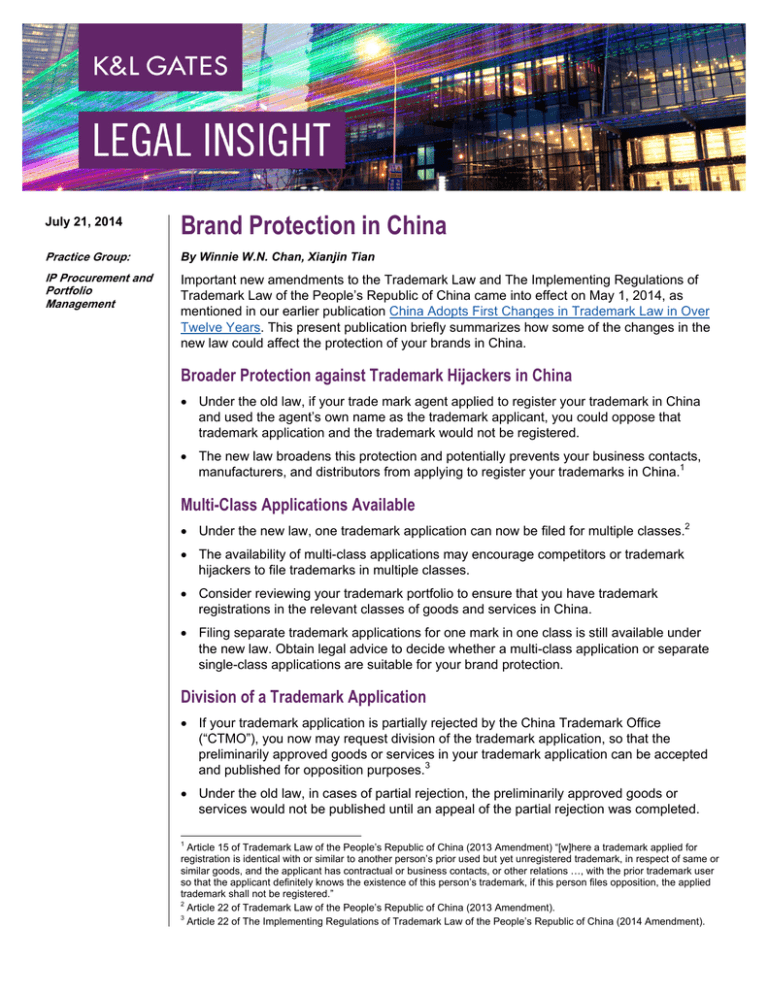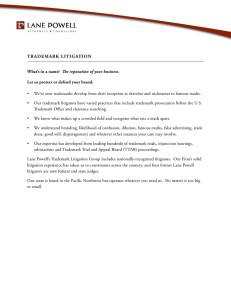
July 21, 2014
Brand Protection in China
Practice Group:
By Winnie W.N. Chan, Xianjin Tian
IP Procurement and
Portfolio
Management
Important new amendments to the Trademark Law and The Implementing Regulations of
Trademark Law of the People’s Republic of China came into effect on May 1, 2014, as
mentioned in our earlier publication China Adopts First Changes in Trademark Law in Over
Twelve Years. This present publication briefly summarizes how some of the changes in the
new law could affect the protection of your brands in China.
Broader Protection against Trademark Hijackers in China
Under the old law, if your trade mark agent applied to register your trademark in China
and used the agent’s own name as the trademark applicant, you could oppose that
trademark application and the trademark would not be registered.
The new law broadens this protection and potentially prevents your business contacts,
manufacturers, and distributors from applying to register your trademarks in China.1
Multi-Class Applications Available
Under the new law, one trademark application can now be filed for multiple classes.2
The availability of multi-class applications may encourage competitors or trademark
hijackers to file trademarks in multiple classes.
Consider reviewing your trademark portfolio to ensure that you have trademark
registrations in the relevant classes of goods and services in China.
Filing separate trademark applications for one mark in one class is still available under
the new law. Obtain legal advice to decide whether a multi-class application or separate
single-class applications are suitable for your brand protection.
Division of a Trademark Application
If your trademark application is partially rejected by the China Trademark Office
(“CTMO”), you now may request division of the trademark application, so that the
preliminarily approved goods or services in your trademark application can be accepted
and published for opposition purposes.3
Under the old law, in cases of partial rejection, the preliminarily approved goods or
services would not be published until an appeal of the partial rejection was completed.
1
Article 15 of Trademark Law of the People’s Republic of China (2013 Amendment) “[w]here a trademark applied for
registration is identical with or similar to another person’s prior used but yet unregistered trademark, in respect of same or
similar goods, and the applicant has contractual or business contacts, or other relations …, with the prior trademark user
so that the applicant definitely knows the existence of this person’s trademark, if this person files opposition, the applied
trademark shall not be registered.”
2
Article 22 of Trademark Law of the People’s Republic of China (2013 Amendment).
3
Article 22 of The Implementing Regulations of Trademark Law of the People’s Republic of China (2014 Amendment).
Brand Protection in China
Tougher Damages against Infringers
As of May 1, 2014, serious and malicious trademark infringement may result in damages
of up to three times the amount of the infringer’s profits, the trademark holder’s losses, or
a reasonable license fee.4 As a result of these enhanced awards, you may wish to review
your trademark enforcement strategies in China.
Previously, the damages were only in the amount of the infringer’s profits or the
trademark holder’s losses, and there were no additional penalty damages even in serious
and malicious infringement cases.
Use of Registered Trademarks
It is very important to maintain good records to show use of a registered trademark in
China. If a registered trademark owner cannot prove that a registered trademark was
used in the last three years prior to an infringement action, the infringer of that registered
trademark shall not be liable for damages.5
The old law did not consider use of a trademark within three years as a key factor for
determining damages, although, in practice, courts could have considered such use in
their discretion. Now, the law is explicit, and the burden of proof for use is on the
trademark owner. This may deter trademark owners who have no intention of using a
trademark from filing infringement cases.
Accelerated Time Frames
There are now accelerated time frames for action by the CTMO and Trademark Review
and Adjudication Board (“TRAB”). Time limits have been introduced to speed up the
issuance of decisions relating to trademark applications, oppositions, invalidations, and
cancellations. For example, the time limit for TRAB to review a CTMO rejection decision
is nine months, with a three-month extension.6
The old law was silent on the time frame, and the time used was at the discretion of the
CTMO and TRAB, which, in practice, was generally much longer than the new,
accelerated time frames.
Registration of Sound Marks
The registration of a sound mark is now possible. The applicant must submit a sound
sample, describe the sound trademark to be registered and describe the use of the
trademark. When describing a sound mark, the sound must be described with staff or
numbered musical notation and appended with a description in words.7
The introduction of sound marks expands the scope of the old law, where it was only
permissible to submit a visual representation of a trademark in the form of a trademark
drawing on a trademark application form.
4
Article 63 of Trademark Law of the People’s Republic of China (2013 Amendment).
Article 64 of Trademark Law of the People’s Republic of China (2013 Amendment).
6
Articles 34, 35, and 44 of Trademark Law of the People’s Republic of China (2013 Amendment).
7
Article 8 of Trademark Law of the People’s Republic of China (2013 Amendment).
5
2
Brand Protection in China
Protection for Prior Users
Under the new law, and subject to certain conditions, prior users of a trademark in China
may continue to use a trademark without interference by the owner of a subsequent
trademark registration for an identical or similar trademark, regarding identical or similar
goods.8
Under the old law, prior users did not have this protection against registered trademark
owners that were the “first to file” in China.
Authors:
Winnie W.N. Chan
winnie.chan@klgates.com
+852.2230.3503
Xianjin Tian
xianjin.tian@klgates.com
+86.10.5817.6103
Anchorage Austin Beijing Berlin Boston Brisbane Brussels Charleston Charlotte Chicago Dallas Doha Dubai Fort Worth Frankfurt
Harrisburg Hong Kong Houston London Los Angeles Melbourne Miami Milan Moscow Newark New York Orange County Palo Alto Paris
Perth Pittsburgh Portland Raleigh Research Triangle Park San Diego San Francisco São Paulo Seattle Seoul Shanghai Singapore Spokane
Sydney Taipei Tokyo Warsaw Washington, D.C. Wilmington
K&L Gates comprises more than 2,000 lawyers globally who practice in fully integrated offices located on five
continents. The firm represents leading multinational corporations, growth and middle-market companies, capital
markets participants and entrepreneurs in every major industry group as well as public sector entities, educational
institutions, philanthropic organizations and individuals. For more information about K&L Gates or its locations,
practices and registrations, visit www.klgates.com.
This publication is for informational purposes and does not contain or convey legal advice. The information herein should not be used or relied upon in
regard to any particular facts or circumstances without first consulting a lawyer.
© 2014 K&L Gates LLP. All Rights Reserved.
8
Article 59 of Trademark Law of the People’s Republic of China (2013 Amendment).
3


